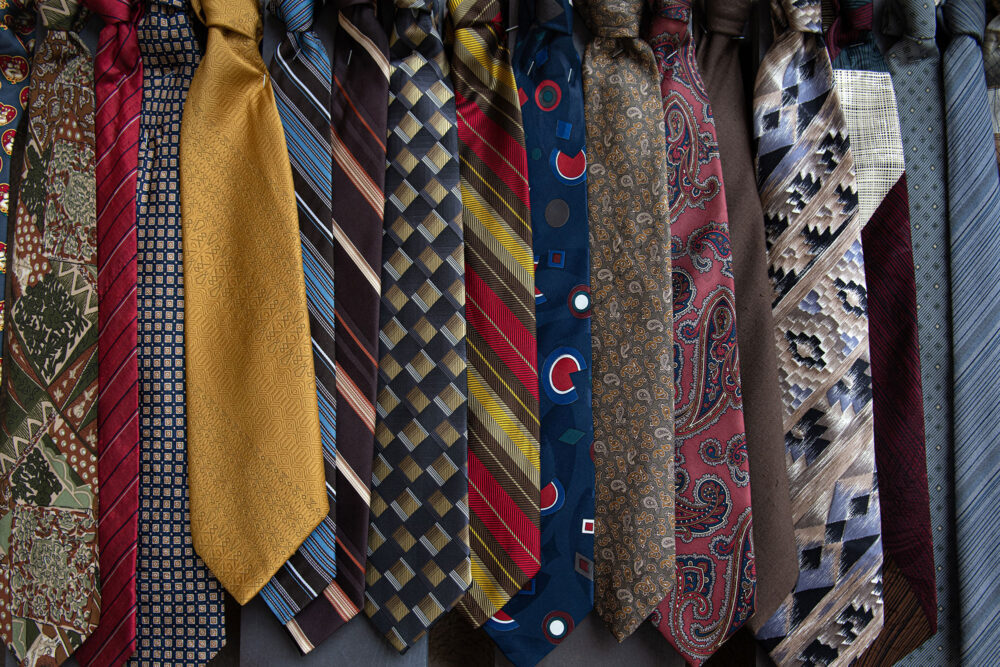What’s Up With That Necktie?
Why We Wear Clothes:
Part 2 – On The Visual Aspects Of Executive Presence: The Philosophy of Attire & Tribal Affiliation
This article is the second of a series that examines some of the visual aspects of leadership image. These are the things you can see that can influence how others perceive you, and, interestingly enough, how you perceive yourself!
In the first article in this series, we discussed bearing, that is, how you hold your body, and the stance, posture, movement, etc. that characterize a leader. (See “Stand Up Straight!”)
THIS ARTICLE is a short overview on the philosophy of attire, cultural norms, and the purposes of uniforms.
SO, WHY DO WE WEAR CLOTHES?
…AT ALL?
Before we look at your wardrobe, let’s step back and take a bigger look – why do we wear clothes at all?
Consider yourself an Alien Clothing Anthropologist for a moment, examining the cultural behaviors and artifacts of these creatures called Human Beings.
Why the heck do your subjects cover themselves in complex, woven textiles, sewn from multiple pieces of varying colors, shapes, etc. that are time-consuming to create and often less-than comfortable to wear?
(What on earth, for example, is the purpose of a necktie?)**
Practical Reasons
Clearly, there are practical reasons to wear clothes – protection, warmth.
And clothes do tell us a lot about the climate and physical situation the wearer comes from. And, unless you’re talking about armor or a hard hat, an animal skin or big leaf would actually work just fine. Better, in many cases. So, aside from the snow and splinters things, what do clothes do?
As you no doubt see in your role of Alien Anthropologist, clothes tell us about the culture or tribe of the wearer.
Appearance As A Cultural “Norm”
Any culture gets defined as a culture because it has certain “norms.” We know that many gestures, ways of speaking, walking or making eye contact are learned, and are part of the cultural system.
Appearance is one of the most obvious cultural norms.
Within any given culture, there is a general consistency around clothes, makeup, jewelry, war paint, piercings, etc., as well as such things as hair length, facial hair, body hair, tattoos, fingernail treatment, and prevalence of plastic surgery.
✓ Aesthetics
✓ Values
✓ What’s “approrpiate”
Clothes – as well as accessories and modifications of the body, and how much of the body is shown or covered up – tell us about the aesthetics of a culture – what people find attractive, or powerful-looking – and also about the values of the culture and what is considered appropriate.
How you conform to – or ignore – these norms tells others what “tribe” you consider yourself to be part of.
Clothes both distinguish you from, and link you to your tribe.
Our Tribal Affiliation
Every culture has a kind of tribal affiliation uniform. This includes the cultures of New Guinea tribesmen, Goth Teenagers, Marines, High School band members, and Corporate Executives.
The Purpose Of A Tribal Affiliation Uniform
The uses of ALL uniforms are similar.
Aside from the aesthetic values (“We think this is pretty”) or the moral ones (“Women’s legs should be covered”) there are a number of other purposes.
You may think of many more; here are some that I know of:
✓ Uniforms indicate roles and status. You can generally tell from a uniform what people do and/or who is in charge. Managers wear ties; generals wear braid.
✓ Uniforms indicate type of activity. For example, the military has different uniforms for working, fighting and going to formal dinners. Most people dress differently for a football game than a job interview. (And, a Goth on a job interview still probably looks different than a marine….)
✓ Uniforms tell us who is on which side. Uniforms group people, often into “friend” or “foe.”
✓ Many people, all in uniform, create a greater impact. A group of people dressing or behaving in a synchronous way creates a sense of size and scope, and is perceived as more powerful and dramatic than the same number dressing or moving differently. Think Red Square Parade, or chorus line.
✓ A uniform takes away one way of judging based on appearance. If the element of attire is made irrelevant, you can concentrate on performance. Schools, monasteries, etc. have used this technique for possibly thousands of years.
✓ People tend to like people they perceive as being like themselves and uniforms aid in that.
Human beings are hard-wired to be tribe-interpreting/ in-crowd-out-crowd geniuses.
Note: Brain chemistry research around mirror neurons is interesting on this topic. See Mirroring People: The New Science of How We Connect With Others, a great new book by Marco Iacoboni.
A STORY:
When I was starting out in my career, I was a field sales rep for Gillette. One time, a group of high-level people from the Boston Headquarters came out to visit my key account – Thrifty Drug.
The morning of the call, all of us showed up at the account wearing navy blue blazers, grey or beige slacks (I wore a skirt), and white or blue shirts. The men’s ties were all similar – red-and-blue “rep” pattern.
Nobody had communicated ahead of time, nothing was written down, and no one had ever told any of us that this was the “uniform.” And yet, there we were, five of us, dressed virtually identically. The Thrifty Buyers were amused….
Every Item Defines Us To Others (And To Ourselves…)
Every item we wear tells others something about what army – or razor blade vendor – we consider ourselves to be part of, what country we come from, our socio-economic status, and something about our values, beliefs and aesthetics.
Anyone from the military services will tell you a list of things that they know about a person from their military uniform. And, the rest of us are the same in our ability to make judgments about who is, or is not, on our team.
THINK: Back when you were 10 or 12…did you dress like your friends? Why did you do that?
THINK: Even now, what does a Preppie look like? A Goth…a Biker Chick….a Jock….Nerd….a Hippie…a Soccer Mom or an Orange County housewife?
Those people – those 12 year-olds, those short-haired polo-shirt-and-khaki wearers, those slim, botox-browed, plump-lipped blondes, have indicated their tribal affiliation in part by their clothing and body modifications.
There Is No Such Thing As “Out Of Uniform”
Every outfit is a uniform.
Every one. No exceptions. And every company and organization has written or unwritten rules about what their uniform is, what the tribal accessories are, etc., so we can quickly recognize our fellow-members.
If you’re alive, you’re in some sort of uniform – even naked. Hair length and style, fingernail length – for men or women – calluses, tattoos, piercings, what and where you shave or don’t shave, are all tribal affiliation choices.
Even non-conformists tend to dress like the tribe “Non-conformists!”
A STORY:
My mother is an artist, and a good one (see www.oldgraymare.net). When she attends any event that might connect with her art – receptions, parties, etc. – she tends to dress in ways that are more than slightly over-the-top, especially for your standard almost-89-year-old woman.
She wears things like wildly-printed Indian caftans, huge, exotic jewelry, or a hat with a rattlesnake skin band, or giant African porcupine quills to hold her hair in place, etc. She says, “Cindy, people want artists to look like artists!”
But What About Personal Style?
People ask me: “But what about my personal style? I don’t want to be some kind of clone!”
To you, this may mean something like: “I think of myself as a novelist trapped in the role of a HR Benefits manager…I work here, but it isn’t really me!”
To me, and to others, this means one – or more – of the following:
✓ Complexity:
You have multiple affiliations – you’re a Goth AND an Orange County housewife – and you wish people to see your complexity and stay loyal to both callings. (Now there’s a picture!) This may be good – or bad.
✓ Commitment:
You are not 100% committed to us, your “working” tribe, and are dissing us. This is likely to be bad.
✓ Attentiveness:
You are either careless about, or inattentive to common standards. Also likely to be bad.
So, imagine someone is evaluating your potential for growth within their own cultural system – one they value and to which they are committed.
If they see you looking somehow “out of place,” do you think are they more likely to judge you as: a) interesting and complex, or, b) uncommitted, conflicted, and careless?
Humans Are Wired To Guess The Negative First
It’s hard to know for sure how people will judge.
And, there are lots of good, evolutionary reasons that we are wired to “guess” the bad/negative reason first.
As I often say, you’re better off guessing (wrongly) that the weird, dark shape is a saber tooth tiger, and having it turn out to be a bush, than you are guessing (wrongly) it’s a bush, and having it turn out to be a tiger with lunchtime desires.
In the same way, guessing that someone might not be part of your tribe or an enemy, and having them turn out to be a friend, is safer than thinking they are part of your tribe, and having them turn out to be an enemy. It is fine to be different.
And…most people are more comfortable, trusting and happy around people who they perceive as “like” them in some way.
Know What You Are Choosing
You’re (probably!) a grown-up. You get to choose.
And peoples’ variety and differences are what makes life interesting.
You may say, “If that can’t take me the way I really am, I don’t want to work here.” That’s perfectly fine – and, recognize that is your choice, not theirs. And neither of you is wrong.
Conversely, the closer you appear to the “norms” of a culture in your appearance – be it blue suit or Hawaiian shirt – the more quickly people will focus on your performance. Again, that’s one of the reasons schools often promote uniforms.
Keys To Choice
It is important to remember three key things:
✓ Recognize that you ARE choosing
✓ Ask WHO you are dressing for
✓ Remember “YOU” are not your uniform
1) Recognize that you are choosing:
Notice, and chose on purpose, not by accident.
Understand that when you veer from a norm or standard, all those tribal affiliation geniuses out there will notice, sometimes only unconsciously, and will judge you – for better or worse.
People who see you veer will at least be curious about why you have done so – is it lack of commitment or complexity, inattentiveness or carelessness? Those who value commitment to the tribe – often those in charge – may well see it as a lack.
The question then becomes: Are your choices working for you or against you…and how much do you care?
2) Ask WHO you are dressing for (or whom):
If you’re dressing to impress the guy or woman in the next cubicle about how attractive and sexy you are, that’s a choice. If you’re dressing because you want people to know you have a different side, or because you want to show you’re “not a corporate clone,” that’s a choice. If you’re dressing to affiliate with other leaders, that’s a choice, too.
All of these are legitimate choices.
What is NOT a choice is this: Others will notice that you are different from them, or similar to them, and they will have an opinion about it.
The question is: Are the people/tribes you are dressing for the ones who will help you reach your goals – whatever they are?
3) Remember “YOU” are not your uniform:
Your uniform is only an indicator of the part you are choosing to take action on right now.
Every day, you can choose to dress for a different tribe. It says: “This is the game I am in today.” It doesn’t negate the potential for any other part you might want to take on at a different time.
You get to choose, and you get to change if that uniform and the role no longer suit you (pun intended…).
The question is: Which part is most important to you today?
A Caveat:
Some of you will react by thinking, “But I know people who have succeeded despite flaunting the rules of the uniform!”
So do I.
And, all of them were one or more of the following: brilliant, charming, articulate, incredibly stubborn, blessed with natural beauty, guts and/or a good mentor (or successful relative), or possibly were just incredibly and dangerously vicious. Or, it took them a lot of extra time to get where they were going.
Do you want to bet that you are like them? And with how big a gesture?
As a note, I am the last person to think everyone should be exactly alike.
I deeply value the amazing and wonderful variety of people, tribes and really well-chosen accessories. Bright colors and shiny objects make my eyes happy, and those of you who know me may comment that I have occasionally veered from various standards myself. (There are pictures.)
However, as I said earlier, always work to know what you are choosing and why, and be realistic about how others may react.
Finally
In my next article, I’ll discuss neckties, Hawaiian shirts, skirts vs. pants, accessories, hair, and the wardrobe of corporate America.
Until Then Practice With The Exercise, (below) and
Use My Standard Rules Of Thumb:
Observe the people around you and recognize their tribes dress like the tribe of people with whom you choose to be affiliated.
(**I am told by a man who should know that the purpose of the necktie is to show you are willing to suffer for your tribe….)
EXERCISE: ALIEN ANTHROPOLOGIST
Or, “Why the Heck Are They Doing That?”
Do the next exercises as if you were an extraterrestrial from the planet Betaglobula, and had no values attached to anything here on Earth.
Be a dispassionate observer. Stay curious, and withhold thoughts of good and bad – those are YOUR cultural norms coming through.
1) General View:
Find a place where you can sit and watch the passing parade of people. (Restaurant, Starbucks, airport, park bench, bus, beach, etc.)
✓Pick people out of the crowd
✓Look at how they walk – What does this tell you?
✓Notice how you can identify groups by the way they walk – teenagers have a walk, cops have a walk, different cultural groups walk differently
✓Look at what they are wearing
✓Try to guess what activities they are, or are not participating in
✓Try to guess what “tribes” they might affiliate with -feel free to make up your own names for them!
✓Check out their accessories or body changes – what does this tell you?
✓What do their shoes tell you – anything? (For example: You can often tell if someone drives a manual or automatic car by his or her shoes….)
✓What about hair, style and length – what does this tell you?
2) Specific View:
Look at the people at your workplace
✓What is the general uniform? Suit? Slacks and a jacket, Bermuda shorts and a
✓Hawaiian shirt? Colorful, plain, conservative, sloppy, uniformed….?
✓Do different groups dress differently? If so, how so? Managers? Executives? What do they have in common?
✓If the men wear ties, what kind? Do the women wear pants or skirts? Lots of jewelry? Makeup?
✓What can you tell about each person’s role from his or her clothes?
✓Compare this to what you are wearing. What are you telling them?
✓Ask yourself: Is this what I want to say?







